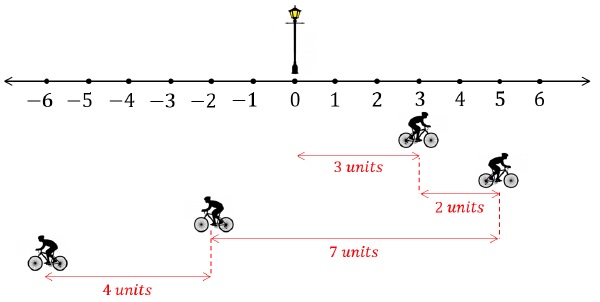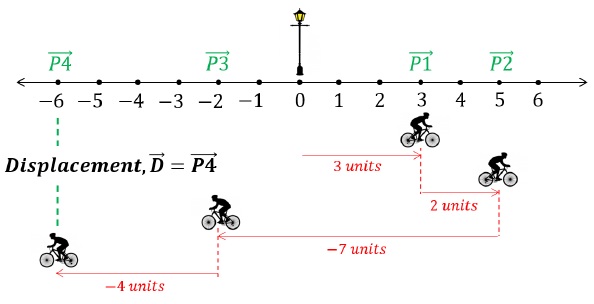Position, Path Length & Displacement
Description:
Vectors in 1-D (One dimension)
Straight Line represents one dimension.
Only two directions are possible in one dimension.

Any direction can be chosen to be positive. By convention, the opposite becomes negative.
By Mathematical standards
- Right direction may be represented by positive sign.
- Left direction may represented by negative sign.
Position
Position can be understood as the location of an object with respect to a reference point. It is expressed as a position vector.
Shown below is the position of a cyclist with respect to a lamp post. Cyclist starts at the lamp post and goes to Position 1, 2, 3 and 4 respectively.

Position 1, P1→ = +3 units
Position 2, P2→ = +5 units
Position 3, P3→ = -2units
Position 4, P4→ = -6units
Path Length/Distance
The total length of the path covered by the moving object. It is a scalar.
Following shows the distance covered by the same cyclist.

Path Length = 16 units = Distance
Displacement
Shortest distance between the initial and final positions. It is a vector.

Final Displacement, D→ = -6 units
It is interesting to observe the that final displacement vector is same as the final position vector. This is because,
P1→ + P2→ + P3→ + P4→
D→ = 3 + 2 - 7 - 4 = -6 units
General Formula of Displacement
Displacement between two positions starting at PA→ and ending at PB→ is defined as −
Displacement, D→ = PB→ - PA→
For Example, in the figure below,

Displacement between position 2 and position 4,
D→ = P4→ - P2→ = -6 - (+5) = -11 units
Distance and Displacement Relationship
Magnitude of Displacement may or may not be equal to Distance.
For example, in the figure below,

Between P1→ and P2→ −
Distance = 2 units
Magnitude of displacement = |+5 - (+3)| = 2 units
Between P1→ and P3→ −
Distance = 9 units
Magnitude of displacement = |-2 - (+3)| = 5 units
Important Note
If the object doesn’t change direction during motion, distance is equal to magnitude of displacement. (as evident between P1→ and P2→)
If the object changes direction during motion, distance is always greater than displacement. (as evident between P1→ and P3→)

